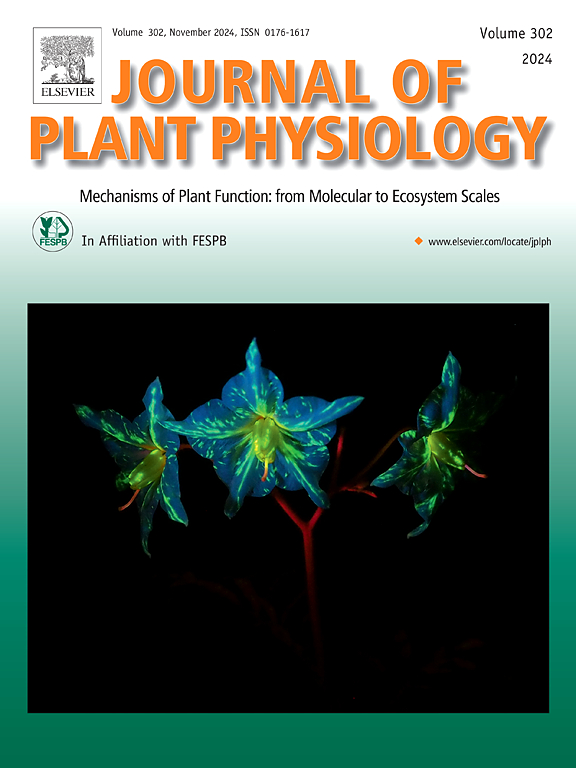Identification of RAV transcription factors (B3-domain-containing) and functional analysis of OsRAV2 in rice blast and drought stress
IF 4.1
3区 生物学
Q1 PLANT SCIENCES
引用次数: 0
Abstract
RAV transcription factors play roles in a variety of diverse biological processes. However, their role in rice's response to drought and blast stress remains largely unexplored. In this study, we performed a genome-wide characterization and identification of rice RAV transcription factor family genes. Our analysis of gene structure, chromosome location, cis-regulatory elements, and collinearity revealed the phylogenetic characteristics of this gene family. The RT-qPCR of the 15 genes showed that the expression levels of OsRAV2 were up-regulated under the two stress treatments. The overexpression of OsRAV2 enhanced drought resistance through the regulation of Pro, MDA and H2O2 levels, and the transcription levels of ABA signaling pathway genes. Additionally, the overexpression of OsRAV2 enhanced rice resistance to blast disease by increasing the accumulation of Pro and H2O2, along with the expression of disease resistance-related genes. OsRAV2 is localized in the nucleus and interacts with OsLHCB5. This study reveals the positive role of OsRAV2 in enhancing drought and blast resistance of rice, and nuclear localization and interaction with OsLHCB5 revealed that OsRAV2 responds to stress by integrating light signals, which provides a new target for breeding rice varieties with broad-spectrum stress resistance.
水稻稻瘟病和干旱胁迫下RAV转录因子(含b3结构域)鉴定及OsRAV2功能分析
RAV转录因子在多种多样的生物过程中发挥作用。然而,它们在水稻对干旱和稻瘟病胁迫的反应中所起的作用在很大程度上仍未被探索。在这项研究中,我们进行了水稻RAV转录因子家族基因的全基因组鉴定和鉴定。我们对基因结构、染色体位置、顺式调控元件和共线性的分析揭示了该基因家族的系统发育特征。15个基因的RT-qPCR结果显示,在两种胁迫处理下,OsRAV2的表达水平均上调。OsRAV2过表达通过调控Pro、MDA和H2O2水平以及ABA信号通路基因转录水平增强抗旱性。此外,OsRAV2的过表达通过增加Pro和H2O2的积累,以及抗病相关基因的表达,增强了水稻对稻瘟病的抗性。OsRAV2定位于细胞核并与OsLHCB5相互作用。本研究揭示了OsRAV2在提高水稻抗旱性和抗稻瘟病性方面的积极作用,核定位和与OsLHCB5的互作揭示了OsRAV2通过整合光信号响应胁迫,为选育广谱抗逆性水稻品种提供了新的靶点。
本文章由计算机程序翻译,如有差异,请以英文原文为准。
求助全文
约1分钟内获得全文
求助全文
来源期刊

Journal of plant physiology
生物-植物科学
CiteScore
7.20
自引率
4.70%
发文量
196
审稿时长
32 days
期刊介绍:
The Journal of Plant Physiology is a broad-spectrum journal that welcomes high-quality submissions in all major areas of plant physiology, including plant biochemistry, functional biotechnology, computational and synthetic plant biology, growth and development, photosynthesis and respiration, transport and translocation, plant-microbe interactions, biotic and abiotic stress. Studies are welcome at all levels of integration ranging from molecules and cells to organisms and their environments and are expected to use state-of-the-art methodologies. Pure gene expression studies are not within the focus of our journal. To be considered for publication, papers must significantly contribute to the mechanistic understanding of physiological processes, and not be merely descriptive, or confirmatory of previous results. We encourage the submission of papers that explore the physiology of non-model as well as accepted model species and those that bridge basic and applied research. For instance, studies on agricultural plants that show new physiological mechanisms to improve agricultural efficiency are welcome. Studies performed under uncontrolled situations (e.g. field conditions) not providing mechanistic insight will not be considered for publication.
The Journal of Plant Physiology publishes several types of articles: Original Research Articles, Reviews, Perspectives Articles, and Short Communications. Reviews and Perspectives will be solicited by the Editors; unsolicited reviews are also welcome but only from authors with a strong track record in the field of the review. Original research papers comprise the majority of published contributions.
 求助内容:
求助内容: 应助结果提醒方式:
应助结果提醒方式:


